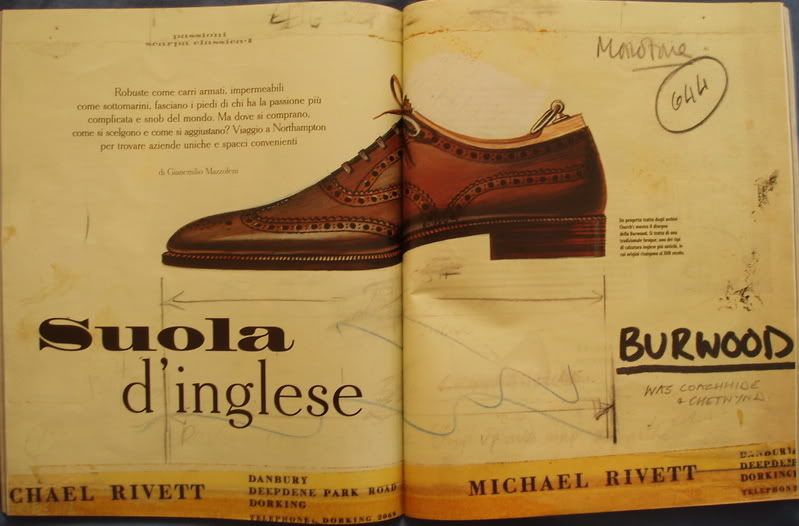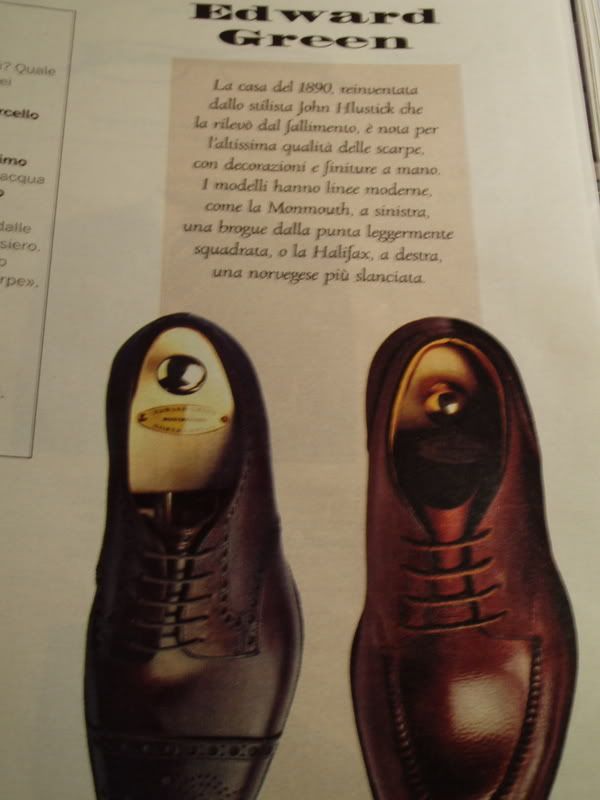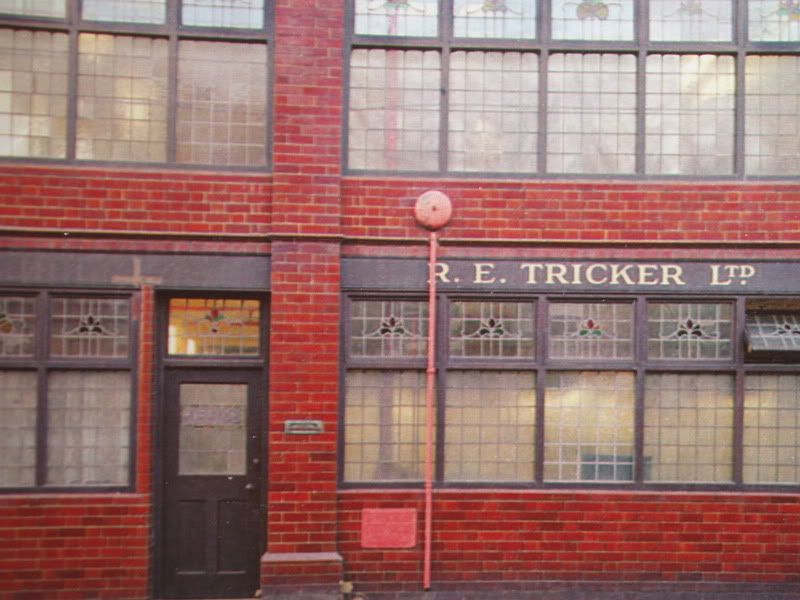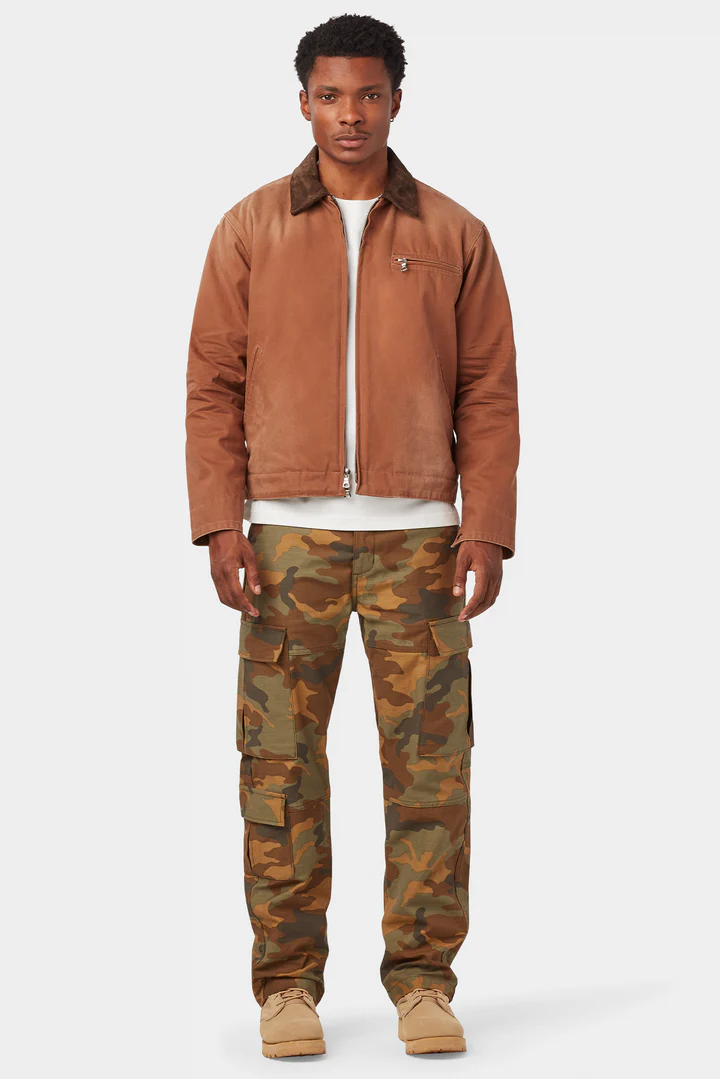This month's Style magazine carries the following two articles. The former is about English shoes, the latter Italian. I hope you enjoy them and that you are not too distracted by my bad translation of the rather prolix Italian original.
 The insert text on the front page next to the shoe illustration (by the heel) says: ‘A design outline from the archives of Church’s shows the design of the Burwood. It outlines the traditional brogue, a type of an older English shoe, which originated in the seventeenth century’.
The insert text on the front page next to the shoe illustration (by the heel) says: ‘A design outline from the archives of Church’s shows the design of the Burwood. It outlines the traditional brogue, a type of an older English shoe, which originated in the seventeenth century’.
 But why prefer Church’s to Edward Green? Questions of taste, and of loyalty to a last which corresponds appropriately with the foot, respond the proprietors, without dispute. Tony Blair, Prince William and a myriad of dandies and professionals all over the world display under their trousers a pair of Church’s. With 600 employees and 4500 pairs a week, the house is present in over 40 countries and has become the symbol of real English footwear. Founded in 1873, it was for 5 generations under the proprietorship of the same family until Prada bought it. But the scions, in the form of Jonathan and William Church, still guide the production that, alongside hundred year-old machines, has introduced computers for design. So, if the main models still remain the Consul, a classic Oxford, the others make their own way, like the Newton, even if respecting traditional design, has been created more modern, with a tapered toe.
But why prefer Church’s to Edward Green? Questions of taste, and of loyalty to a last which corresponds appropriately with the foot, respond the proprietors, without dispute. Tony Blair, Prince William and a myriad of dandies and professionals all over the world display under their trousers a pair of Church’s. With 600 employees and 4500 pairs a week, the house is present in over 40 countries and has become the symbol of real English footwear. Founded in 1873, it was for 5 generations under the proprietorship of the same family until Prada bought it. But the scions, in the form of Jonathan and William Church, still guide the production that, alongside hundred year-old machines, has introduced computers for design. So, if the main models still remain the Consul, a classic Oxford, the others make their own way, like the Newton, even if respecting traditional design, has been created more modern, with a tapered toe.
 (A director of C&J) The clientele are decisively various at Crockett & Jones. Johnny Depp displays Conistons under his jeans; Bernie Ecclestone loves the Savile, the monk which, without laces, is held with buckles which flap; Eric Clapton doesn’t disdain the Handgrade brogue, the most refined, with stitching that is practically invisible. Its size is divided in half between industrial and artisanal, with 230 employees who churn out 2300 pairs a week, and yet has been in the hands of the same family since 1879: Crockett & Jones have survived and innovated by dipping a hand into the archive of hundreds of models, which they also agree to produce for large brands like Brooks Brothers and Ralph Lauren.
(A director of C&J) The clientele are decisively various at Crockett & Jones. Johnny Depp displays Conistons under his jeans; Bernie Ecclestone loves the Savile, the monk which, without laces, is held with buckles which flap; Eric Clapton doesn’t disdain the Handgrade brogue, the most refined, with stitching that is practically invisible. Its size is divided in half between industrial and artisanal, with 230 employees who churn out 2300 pairs a week, and yet has been in the hands of the same family since 1879: Crockett & Jones have survived and innovated by dipping a hand into the archive of hundreds of models, which they also agree to produce for large brands like Brooks Brothers and Ralph Lauren.
 For the gentleman of the country who doesn’t want to give up an elegant but waterproof shoe, there is only one name: Tricker’s. Praise the brogue of the double sole with the reverse Storm Welt, that is to say moulding against the elements, a system with the raised welt (the strip of leather between the sole and the upper) in a way to prevent the least drop getting in. Of his assured generosity as the supreme country gentleman, the Prince of Wales has given only to Tricker’s the certificate of supplier to the royal household. Edward Green is surely a semi-artisinal product (only 300 pairs weekly, made by 40 employees) of sublime characteristics.. It’s enough to say the majority of the decorations are sewn by hand and for the stitching instead of a needle they use an individual bristle from a Chinese piglet so as to give ‘invisible’ holes. The design of the models, then, is modern, also maintaining the classic elegance, fruit of the labour of designer John Hlustick (and today his heirs) who in 1983 bought the house founded in 1890, but on the verge of collapse, for £1. _____________________________
For the gentleman of the country who doesn’t want to give up an elegant but waterproof shoe, there is only one name: Tricker’s. Praise the brogue of the double sole with the reverse Storm Welt, that is to say moulding against the elements, a system with the raised welt (the strip of leather between the sole and the upper) in a way to prevent the least drop getting in. Of his assured generosity as the supreme country gentleman, the Prince of Wales has given only to Tricker’s the certificate of supplier to the royal household. Edward Green is surely a semi-artisinal product (only 300 pairs weekly, made by 40 employees) of sublime characteristics.. It’s enough to say the majority of the decorations are sewn by hand and for the stitching instead of a needle they use an individual bristle from a Chinese piglet so as to give ‘invisible’ holes. The design of the models, then, is modern, also maintaining the classic elegance, fruit of the labour of designer John Hlustick (and today his heirs) who in 1983 bought the house founded in 1890, but on the verge of collapse, for £1. _____________________________

The English sole
As robust as armed tanks, as waterproof as submarines, dressing the feet of those who have passions as complicated as the snobs of the world. But where do they buy them, how do they choose them and how do they repair them? I travelled to Northampton to find unique businesses and suitable outlets. by Gianemilio Mazzoleni It isn’t between the wood paneling of the shoe industry of Jermyn Street in London in which one must look for the soul of the English shoe, but inside the antique walls of the factories of Northampton, 60 kilometres to the north. For 400 years, since Oliver Cromwell ordered 4600 pairs of boots for his army in 1647, the city has enjoyed glory and wealth from soles, uppers and laces. From the start of the second world war it was host to 40 factories with thousands of employees. The fame of the products comes from the robustness and impermeability of the military tradition ( with mythical histories, like those who required that, before putting on a pair of Tricker’s, it was necessary to put them in the bath for ten days to soften them), but also from the refinement of finishing and design demanded from lords and gentlemen, who had to take the same pair of shoes across the muddy terrains of their estates, to inside their houses, and with equal aplomb, to the clubs of London. The styles which defined shoes of quality around the world were born here: the brogue (the most decorated lace-up), the monk (the buckled moccasin inspired by footwear of monks), the Oxford (the most elegant model with the double seam across the toe). Of this greatness, today there remain only four brands of more than 100 years old: Church’s, Crockett & Jones, Edward Green and Tricker’s. The only ones having resisted the advance of mass production from the far east, and the style of the sneaker, now cling to the best of their tradition. A tradition which leaves anyone astonished who visits these factories. The astonishing rise from the discovery that these well-shod refinements were born in a chaotic environment, from industrial revolution, between the decline of pedal sewing machines by Pfaff and Singer , assembled in places without natural light, between the cracking radios (the unknown iPods) and cups of tea left alongside cuts of leather and pots of wax warming on the stove. But find also the poetry of a forgotten rapport between machine and man who coordinate themselves with perfect rhythm between needles, cutters and presses in almost microsurgical operations. There are over 200 mini-operations to complete a shoe. There are those whom for decades have done nothing but cut by hand the parts of a model from a leather of the highest quality, looking for the places where there are no shades of colour. The sewers are real artists of the needle, capable in a few minutes of realizing the most complicated decorations, perforations and stitchings spaced by millimeters; a jeweler-like craft whose work is to file the leather to a point of transparency at the seam. Once finished, the upper is attached on a last ( there’s one for every possible length and width of foot) and left to rest for ten days or so, to assist perfect adhesion. The uniqueness of every pair of shoes is stated by model name, processing number and code in hand written form on the internal leather; a piece of information which will be referred to when the loved brogue is returned after some years to be re-modeled The service of ‘restoration’ is rendered possible from the Goodyear system which unites the sole and the upper without making use of glue. A process which allows total removal of the sole and refixing of the upper on the original form, re-inserting the shoe into the normal cycle of production for a completely new inlay in six weeks, with a cost varying from €120 to €160. Undoubtedly an added value when one spends €400-€500 for the purchase. A value which comes from a real business if we enter the seconds shop of the factory. All the models end-up here which don’t pass the rigorous quality control. Defects are microscopic: if a stitch is not perfectly aligned or there’s a shading in the leather they are valid for 50% discount. A style saving: to have imperfect shoes is a sign of the real gentleman who, as is known, makes the butler wear the new ones. Church’s has a small shop, open to the public, but of defects, of which they mustn’t make many because there are about ten pairs on display. Certainly the space at Crockett & Jones is more ample, with three walls full of models, but it’s open only on Friday afternoons and Saturday; you need to see for yourselves soon; in a few hours they all disappear but the prices are less than €150. Really English, ultimately, the seconds of Tricker’s are in aplace in a courtyard, detailed with small windows and carpets, and unattended. To get a salesman you need to dial ‘10’ on the old telephone, and to have patience.



You want to put ‘Made In Italy’?
If the Italians go on a pilgrimage in the City, the English tread in Vigevano and surroundings. Because the uppers are the best. It is easy to speak of English shoes: a few know that in the heart and in the shoes there are many snooty British, but it’s not alone and in reality there is an Italian shoe. Noblemen like Prince Michael of Kent, cousin of the Queen, or Lord Charles March (the king of the Goodwood Festival of Speed, the super-elite English competition for vintage cars) traditionally maniaical for shoes (strong things, always heavy, waterproof and slush-proof) today not just touching down in London from the mansion in the country they put on their nice pairs of Made In Italy lace-ups with satisfaction. Slender, elegant but, above all, spacious and light; the weight of a feather, here the leather trumps in the shoe of our manufacturers. Owing to discerning work and the softest leathers. On top of that they are even more slender than the British. For this, when in 1938 the Florentine Salvatore Ferragamo opened a shop in London’s Old Bond Street, he scored immediately. His must have, of now and always? The black lace-up, smooth plain toe, highly polished, today proposed by the Tramezza line: that is with a special strip of leather under the sole, where after a few wears it adapts itself perfectly to the form of the foot. Slim and elegant, it’s the queen for evenings spent in smoking jackets, and worn on the feet of Nathaniel Rothschild or Tom Parker-Bowles, the son of Camila. The Rossetti Brothers also arrived in London from Parabiago (Milan); one of the most common Italian brands in the world, from New York to Dubai, from Antwerp to Hong Kong, it was born in 1953. In its window at 196 of snooty Sloane Street, between moccasins and impeccable laced models, the Derby dominates, innovative- even if a classic- thanks to the play of colours in two tones: chestnut first then becoming black at the toe. A model which recalls the thirties and which the dandies wore under their prince of wales suit in the same colours. There are those who alternate with high-laced boots in dark brown suede with leather soles, that the elegant of Chelsea always buy in Sloane Street from Tod’s: saxon genitive but Italian heart. In the window, the place of honour, naturally, to moccasins with rubber soles, unlined and super-light, loved by those passionate for vintage cars: finally they can run about in the Cotswolds at the wheel of their Aston Martins enjoying the most agile ‘heel-toe’ in the world. Creativity’s the other beauty of the Italian shoe. There are some, like Moreschi, the big one in Vigevano (Pavia), which churns out 300 000 pairs a year using the most noble of the jobs by hand: its classic tubular moccasins are appreciated for their softness. There are some, like Santoni, who cleverly amuse; for example the newest double shoe: a laced leather sport-chic model, with inlay and embroidery, upon which a short spat is laced in identical leather to obtain a high-laced boot for the decisively sporty air. Also in the free time, our shoes challenge the English with equal force. Stop to think of those of Tanino Crisci, native of Casteggio (Pavia), but with shops in via Montenapoleone: shoes for the day and night, contructed like art, among whose inimitable moccasins are thosein coloured leather with lateral buckles. Without forgetting the phenomenon of Geox, ‘the shoe which breathes’ invented by the Treviso native Mario Moretti Polegato. Not only sneakers with soles of leather riddled with holes: also brogues in a perfect British style but with special soles of leather which, thanks to an internal membrane, don’t get wet. So, more beautiful shoes than the English ones in reality are Italian? It looks like it’s true. And not only these. You have here madame Berluti, the queen of French shoes? Her grandfather was a native of Le Marche {central Italy}.



